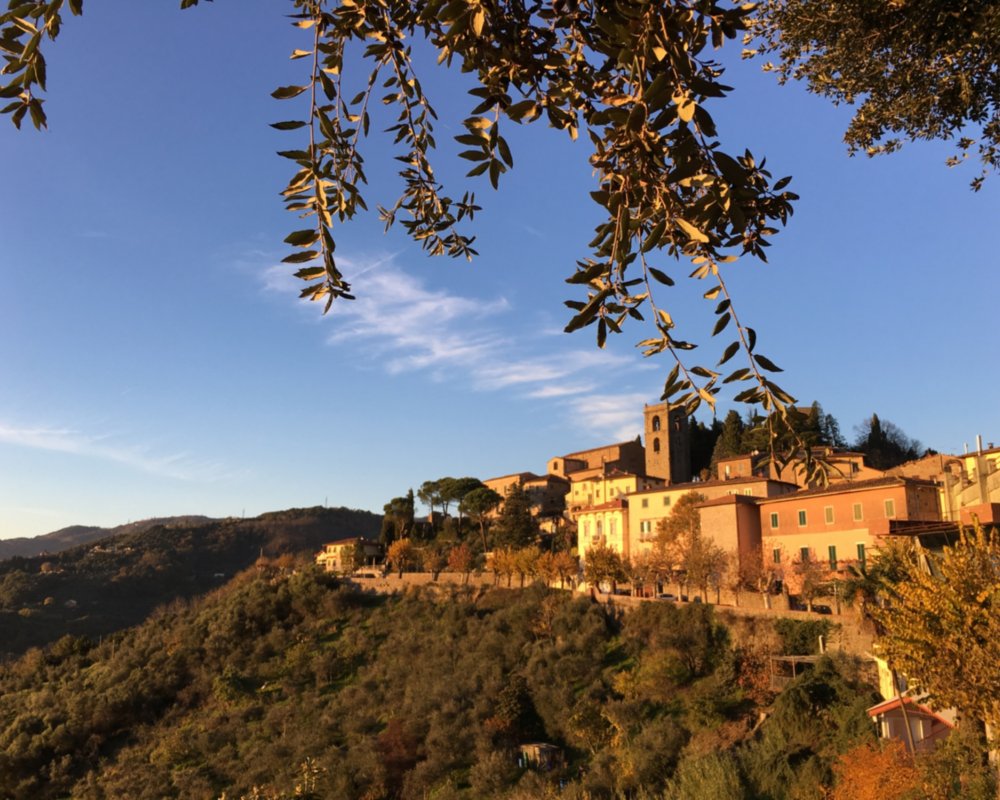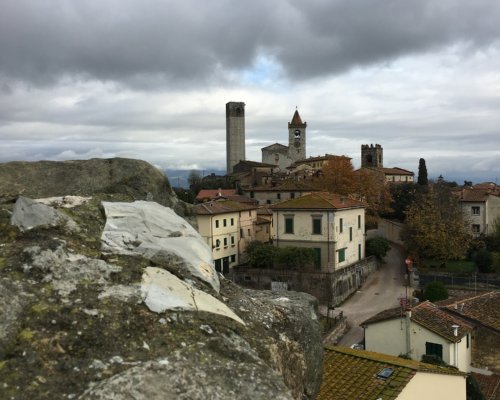Three days of history, art and sensational food among mountains and Valdinievole
Did you know that the Romans were so keen on oysters that they would bring them all the way to the battlefield? And that one of the longest bridges in Europe is found in Tuscany? If you want to learn more about the area - and have three days in which to do so - we suggest you visit the Pistoia villages: small gems that preserve history, art, cuisine and legends. The panoramic view here is sensational at any time of the year. Those who love winter sports can combine culture with the ski slopes: the Abetone and Doganaccia resorts are easily reachable at just a few kilometres from the centre of Pistoia.
This itinerary, which starts from the Pistoia plain, focuses on the small towns in the mountains. This is the perfect opportunity to try local products such as mushrooms, fresh pasta, berries and cheese. The journey ends in Valdinievole where you’ll find yourself surrounded by olive trees, hills and citrus fruits!
If you love medieval villages, you absolutely must visit Serravalle Pistoiese, located a few kilometres away from Pistoia.
Before wandering through the narrow streets of the centre, it’s worth climbing the Longobard Tower (also known as Torre del Barbarossa). A fairly narrow iron staircase leads to the upper part of the building, where you’ll be able to take in the breathtaking panorama of the Pistoia plain. You can still see some remains of the ancient walls of the village and the entrance door to the castle.
If you’re a vertigo-sufferer, the Church of Santo Stefano is perhaps a safer option. Two glazed terracotta sculptures of the Buglioni's workshop are kept here, and represent St. Antonio Abate and St. Lodovico da Tolosa. There’s a deep devotion to San Ludovico in Serravalle Pistoiese; indeed, many locals are often named "Ludovico" after the saint.
Montale is the perfect lunchtime trip for a typical Pistoiese meal. Our recommendations include macaroni with duck, pappa al pomodoro (bread and tomato soup), peposo (beef stew) or tripe. After a hearty meal, you’ll be ready to enter Villa Castello Smilea. In addition to its library, there are various exhibitions and shows (both temporary and permanent) on display.
If you love medieval villages, you absolutely must visit Serravalle Pistoiese, located a few kilometres away from Pistoia.
Before wandering through the narrow streets of the centre, it’s worth climbing the Longobard Tower (also known as Torre del Barbarossa). A fairly narrow iron staircase leads to the upper part of the building, where you’ll be able to take in the breathtaking panorama of the Pistoia plain. You can still see some remains of the ancient walls of the village and the entrance door to the castle.
If you’re a vertigo-sufferer, the Church of Santo Stefano is perhaps a safer option. Two glazed terracotta sculptures of the Buglioni's workshop are kept here, and represent St. Antonio Abate and St. Lodovico da Tolosa. There’s a deep devotion to San Ludovico in Serravalle Pistoiese; indeed, many locals are often named "Ludovico" after the saint.
Montale is the perfect lunchtime trip for a typical Pistoiese meal. Our recommendations include macaroni with duck, pappa al pomodoro (bread and tomato soup), peposo (beef stew) or tripe. After a hearty meal, you’ll be ready to enter Villa Castello Smilea. In addition to its library, there are various exhibitions and shows (both temporary and permanent) on display.
The second day starts with a visit to the Montagna Pistoiese EcoMuseum, which offers 6 different thematic itineraries. Each route has a different focus and delves deeply into a particular aspect of the area. Start at the Madonnina Ice House in Le Piastre: the structure was built in the eighteenth century, when the ice was stored and then resold. Next, head to Maresca (a hamlet in San Marcello Piteglio) and look around the ancient Papini Foundry, where you can follow the phases of iron making and have a go at shaping the metals yourself.
A road trip to Campo Tizzoro offers you the chance to immerse yourself in history. The MIS (Italian Metallurgical Society) Refuge Museum is worth a visit for at least a couple of hours. Bullets, shells, weapons and other copper and brass objects were produced here; the MIS air-raid shelters are unmissable, and are the only remaining underground shelters of this size in Italy.
Head to Melo (a small hamlet in Cutigliano) for a hearty lunch break. Try the legendary tortelli filled with ricotta cheese and spinach, or arista (pork loin) and necci (pancakes) made with chestnut flour. While digesting the meal, take a trip to Ponte Sospeso, one of the highest bridges in the world (40 metres) and about 220 metres long. Built at the beginning of the 20th century, it allowed workers on one side of the mountain to go to work on the other.
Before returning to your hotel, stop at the Popiglio parish church, an intriguing late Romanesque church dedicated to Santa Maria Assunta.
The second day starts with a visit to the Montagna Pistoiese EcoMuseum, which offers 6 different thematic itineraries. Each route has a different focus and delves deeply into a particular aspect of the area. Start at the Madonnina Ice House in Le Piastre: the structure was built in the eighteenth century, when the ice was stored and then resold. Next, head to Maresca (a hamlet in San Marcello Piteglio) and look around the ancient Papini Foundry, where you can follow the phases of iron making and have a go at shaping the metals yourself.
A road trip to Campo Tizzoro offers you the chance to immerse yourself in history. The MIS (Italian Metallurgical Society) Refuge Museum is worth a visit for at least a couple of hours. Bullets, shells, weapons and other copper and brass objects were produced here; the MIS air-raid shelters are unmissable, and are the only remaining underground shelters of this size in Italy.
Head to Melo (a small hamlet in Cutigliano) for a hearty lunch break. Try the legendary tortelli filled with ricotta cheese and spinach, or arista (pork loin) and necci (pancakes) made with chestnut flour. While digesting the meal, take a trip to Ponte Sospeso, one of the highest bridges in the world (40 metres) and about 220 metres long. Built at the beginning of the 20th century, it allowed workers on one side of the mountain to go to work on the other.
Before returning to your hotel, stop at the Popiglio parish church, an intriguing late Romanesque church dedicated to Santa Maria Assunta.
The name Collodi immediately brings to mind Pinocchio, the famous wooden puppet protagonist of a real theme park. But that’s not all the town has to offer: it’s also home to the Historical Garden of Villa Garzoni, where Carlo Lorenzini also spent many of his days since his father was, for some time, a gardener there.
Collodi is a hilltop, typical Tuscan village, made up of small stone streets and narrow alleyways where many sleepy cats take refuge (perfect for a selfie)! Buggiano Castello, or the “citrus town”, is also nearby. There is an omnipresent sense of peace and serenity here, with a breathtaking view of the Valdinievole. A little known fact of the town is that its houses are often a "buggianese red" colour, distinguishing them from the other neighbouring houses.
Montecatini Alto is the perfect lunch destination; head there via the picturesque Funicular. In the central square, pick whatever restaurant or osteria grabs your attention and you’ll be sure to be amazed by the authentic flavours! Autumnal specialties tend to be based on mushrooms and chestnuts, or cheeses enriched with fig jam. You’ll find roasts, Montecatini waffles and quality wines all year round.
The name Collodi immediately brings to mind Pinocchio, the famous wooden puppet protagonist of a real theme park. But that’s not all the town has to offer: it’s also home to the Historical Garden of Villa Garzoni, where Carlo Lorenzini also spent many of his days since his father was, for some time, a gardener there.
Collodi is a hilltop, typical Tuscan village, made up of small stone streets and narrow alleyways where many sleepy cats take refuge (perfect for a selfie)! Buggiano Castello, or the “citrus town”, is also nearby. There is an omnipresent sense of peace and serenity here, with a breathtaking view of the Valdinievole. A little known fact of the town is that its houses are often a "buggianese red" colour, distinguishing them from the other neighbouring houses.
Montecatini Alto is the perfect lunch destination; head there via the picturesque Funicular. In the central square, pick whatever restaurant or osteria grabs your attention and you’ll be sure to be amazed by the authentic flavours! Autumnal specialties tend to be based on mushrooms and chestnuts, or cheeses enriched with fig jam. You’ll find roasts, Montecatini waffles and quality wines all year round.


